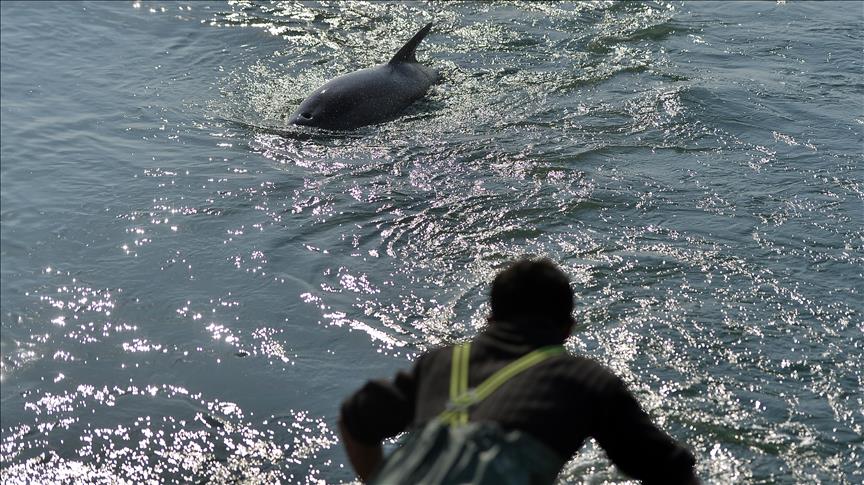Pakistan's blind dolphins moving away from extinction
Rare special has seen a resurgence in recent years
 file photo
file photo
By Aamir Latif
KARACHI, Pakistan
Despite a significant increase in the population of Pakistan’s blind dolphins, the rare mammal is still under constant threat from increasing levels of water pollution and fishing, experts have said.
Locally known as
Another species of this dolphin is found in the Ganges and
According to the Worldwide Fund for Nature (WWF), the population of blind dolphins -- also known as Indus dolphins -- has increased from about 1,300 in 2011 to over 1,800 in 2017, which is a welcome sign.
“This is an encouraging development that the numbers of Indus dolphins have shown a gradual increase since comprehensive surveys started monitoring the population from 2001. But that does not mean we should stop caring for the species”, Uzma Khan, global river dolphins coordinator for the WWF, told Anadolu Agency.
The local fishing community helps the WWF and other wildlife conservation agencies save this rare species.
“I will give credit to the local fishermen who were initially persuaded and trained by the WWF to join the efforts aimed at protecting the Indus dolphins”, Uzma said and added: “Most of the deaths (of dolphins), in recent past, were reported due to accidental entanglement in nets (used by the fishermen).
“But they are now trained to release the dolphins back
Massive floods in 2010 and 2011, which inundated a fifth of Pakistan, are cited as another reason for improving the habitat of the blind dolphins, by washing away pollutants and improving the water quality.
“The water level is very important for breeding these dolphins. Low water level means meager food resources and more chances of accidental deaths and entrapments in nets and canals during movement in search of food”, Uzma explained.
A majority of blind dolphins are found in a stretch of 200 kilometers from Guddu barrage to Sukkur barrage in southern Sindh province, which has already been declared a “dolphin reserve” by the provincial government, according to Taj Mohammad Shaikh, deputy conservator of Sindh wildlife department.
“Chances of accidental deaths are high in winters when the water level in the River Indus is low, and the blind dolphins enter the adjoining canals in search of food, mainly fish and entangle in the nets erected by the local fishermen,” Shaikh told Anadolu Agency.
In case of an accidental death, those responsible are fined Rs50,000 ($450). “It [blind dolphin] is pure fat. You cannot use
Still endangered
The WWF has released 131 blind dolphins back in the River Indus since 1999, said a report issued by the organization earlier this month.
However, despite the encouraging development, the rare mammal, Uzma observed, is still under constant threat.
“The challenges this rare mammal is facing, are still there. There is no reduction in that as its already-shrunk habitat is under constant pressure from fishing,” she said.
Increasing water diversion for agriculture, the release of untreated industrial sewage, illegal fishing practices
Hammad Naqi Khan, the director general of WWF Pakistan chapter agrees. “While celebrating this success we must also remember that the Indus dolphin still faces a host of threats from habitat loss to stranding in irrigation canals and entanglement in fishing nets which can only be eliminated by strengthening conservation efforts and ensuring that these recent population increases are not reversed,” Khan was quoted as saying in the organization’s annual report.
Not only that, dolphins have already disappeared from 80 percent of the Indus River, but they are completely extinct from the country’s northeastern rivers of Sutlaj, Byas
The remaining habitat of the Indus River is fragmented because of the barrages. “If blind dolphins are found in a river, that means it is a healthy river because they are at the top of the food chain and are referred to as an indicator species,” Uzma maintained.
Anadolu Agency website contains only a portion of the news stories offered to subscribers in the AA News Broadcasting System (HAS), and in summarized form. Please contact us for subscription options.







